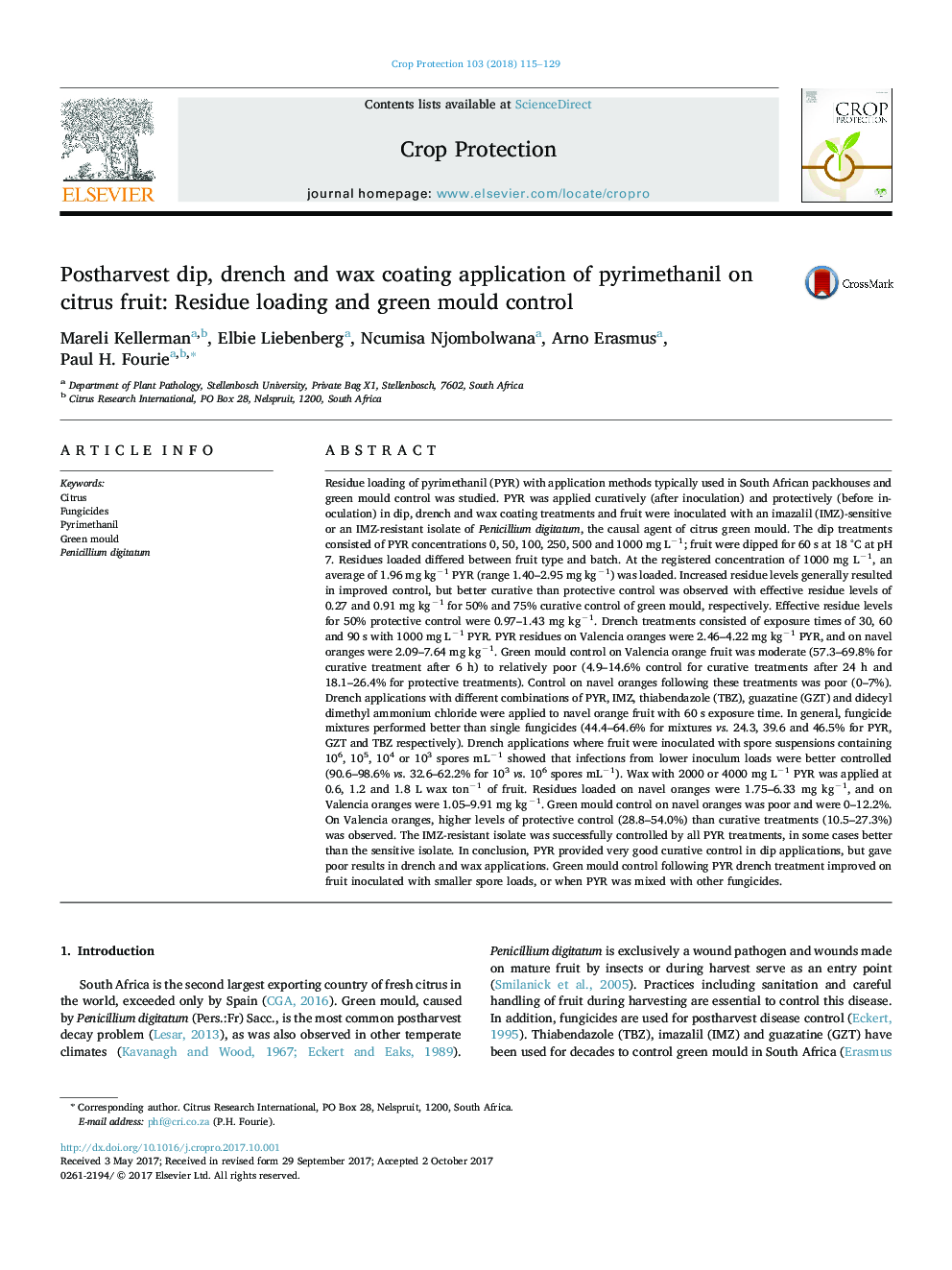| کد مقاله | کد نشریه | سال انتشار | مقاله انگلیسی | نسخه تمام متن |
|---|---|---|---|---|
| 5760996 | 1624284 | 2018 | 15 صفحه PDF | دانلود رایگان |
عنوان انگلیسی مقاله ISI
Postharvest dip, drench and wax coating application of pyrimethanil on citrus fruit: Residue loading and green mould control
ترجمه فارسی عنوان
پوسته پوسته شدن بعد از برداشت و استفاده از موم پیریمتانیل روی میوه مرکبات: بارگیری باقی مانده و کنترل قالب سبز
دانلود مقاله + سفارش ترجمه
دانلود مقاله ISI انگلیسی
رایگان برای ایرانیان
کلمات کلیدی
موضوعات مرتبط
علوم زیستی و بیوفناوری
علوم کشاورزی و بیولوژیک
علوم زراعت و اصلاح نباتات
چکیده انگلیسی
Residue loading of pyrimethanil (PYR) with application methods typically used in South African packhouses and green mould control was studied. PYR was applied curatively (after inoculation) and protectively (before inoculation) in dip, drench and wax coating treatments and fruit were inoculated with an imazalil (IMZ)-sensitive or an IMZ-resistant isolate of Penicillium digitatum, the causal agent of citrus green mould. The dip treatments consisted of PYR concentrations 0, 50, 100, 250, 500 and 1000 mg Lâ1; fruit were dipped for 60 s at 18 °C at pH 7. Residues loaded differed between fruit type and batch. At the registered concentration of 1000 mg Lâ1, an average of 1.96 mg kgâ1 PYR (range 1.40-2.95 mg kgâ1) was loaded. Increased residue levels generally resulted in improved control, but better curative than protective control was observed with effective residue levels of 0.27 and 0.91 mg kgâ1 for 50% and 75% curative control of green mould, respectively. Effective residue levels for 50% protective control were 0.97-1.43 mg kgâ1. Drench treatments consisted of exposure times of 30, 60 and 90 s with 1000 mg Lâ1 PYR. PYR residues on Valencia oranges were 2.46-4.22 mg kgâ1 PYR, and on navel oranges were 2.09-7.64 mg kgâ1. Green mould control on Valencia orange fruit was moderate (57.3-69.8% for curative treatment after 6 h) to relatively poor (4.9-14.6% control for curative treatments after 24 h and 18.1-26.4% for protective treatments). Control on navel oranges following these treatments was poor (0-7%). Drench applications with different combinations of PYR, IMZ, thiabendazole (TBZ), guazatine (GZT) and didecyl dimethyl ammonium chloride were applied to navel orange fruit with 60 s exposure time. In general, fungicide mixtures performed better than single fungicides (44.4-64.6% for mixtures vs. 24.3, 39.6 and 46.5% for PYR, GZT and TBZ respectively). Drench applications where fruit were inoculated with spore suspensions containing 106, 105, 104 or 103 spores mLâ1 showed that infections from lower inoculum loads were better controlled (90.6-98.6% vs. 32.6-62.2% for 103vs. 106 spores mLâ1). Wax with 2000 or 4000 mg Lâ1 PYR was applied at 0.6, 1.2 and 1.8 L wax tonâ1 of fruit. Residues loaded on navel oranges were 1.75-6.33 mg kgâ1, and on Valencia oranges were 1.05-9.91 mg kgâ1. Green mould control on navel oranges was poor and were 0-12.2%. On Valencia oranges, higher levels of protective control (28.8-54.0%) than curative treatments (10.5-27.3%) was observed. The IMZ-resistant isolate was successfully controlled by all PYR treatments, in some cases better than the sensitive isolate. In conclusion, PYR provided very good curative control in dip applications, but gave poor results in drench and wax applications. Green mould control following PYR drench treatment improved on fruit inoculated with smaller spore loads, or when PYR was mixed with other fungicides.
ناشر
Database: Elsevier - ScienceDirect (ساینس دایرکت)
Journal: Crop Protection - Volume 103, January 2018, Pages 115-129
Journal: Crop Protection - Volume 103, January 2018, Pages 115-129
نویسندگان
Mareli Kellerman, Elbie Liebenberg, Ncumisa Njombolwana, Arno Erasmus, Paul H. Fourie,
